From chromosome to gene - PowerPoint PPT Presentation
1 / 12
Title:
From chromosome to gene
Description:
From chromosome to gene. Eukaryotes contain a nucleus in which the ... DNA can bend and kink. nucleosome. DNA. 10 nm fiber. 30 nm fiber. Protein matrix ... – PowerPoint PPT presentation
Number of Views:67
Avg rating:3.0/5.0
Title: From chromosome to gene
1
From chromosome to gene
- Eukaryotes contain a nucleus in which the
chromosomes are located - DNA
- 4 bases AT and C?G
- double helix with the bases as steps and a
sugar-phosphate backbone - Packaging is required to get all the DNA inside
the nucleus - double helix
- nucleosomes histone-DNA complex
- 10 nm fiber string of nucleosomes
- 30 nm fiber coil of string of nucleosomes
- DNA fiber attached to protein matrix at MARs
formation of loops. - A chromosome is a structure made of DNA and
proteins. The metaphase chromosome represents
most compact form of packaging - Euchromatin open structure active genes
- Heterochromatin highly packaged structure
inactive genes
2
- A, B, Z conformation of DNA
- the B-conformation is the typical Watson-Crick
double helix. - the A-conformation occurs when DNA is dehydrated
- the Z-conformation is formed as a result of a
certain base-order this is a left handed helix. - DNA can bend and kink
3
DNA
nucleosome
4
30 nm fiber
10 nm fiber
5
Loops of histone depleted DNA
Protein matrix
6
- Overview of gene expression in plants
exon
5
3
intron
promoter
AATAA
transcription
ATG
STOP
AAAAn
splicing
3UTR
5UTR
ORF
AAAAn
processing
nuclear export
mRNA degradation
translation, post-translational modification,
folding
active protein
protein degradation
7
Transcription
- In eukaryotes transcription is carried out by
three different RNA polymerases - RNA polymerase I 28S, 5.8S and 18S rRNA
- RNA polymerase II protein coding genes and most
snRNAs - RNA polymerase III 5S rRNA, tRNA, U6 snRNA
- Transcription initiation. Binding of RNA
polymerase II to the promoter region of the gene.
This is mediated by the TBP (TATA-binding
protein) and at least 12 TAFs (TATA-binding
protein Associated Factors), together called
TFIID. The TATA-box is a sequence found around
pos. 25 in the promoter. A number of additional
transcription factors (TFIIA, B, E, F, H) are
involved in stabilizing the complex (A),
recruiting RNA polymerase II (B, F), opening the
DNA helix and phosphorylating the C-terminal
domain of RNA Pol II (H). Phosphorylation allows
the polymerase to leave the initiation complex. - 2. Capping. After initiation of transcription
by RNA pol II the pre-mRNA is capped at the 5
end. The cap results from a GTP molecule
reacting with the 5 end of the mRNA to give a
5-5 bond. This is catalyzed by guanylyl
transferase. The N7 position of the G residue is
then methylated (cap 0) by guanine
methyltransferase, but the 3 OH group of the
first two bases of the mRNA may also be
methylated (cap1 and cap2). - 3. Elongation. Transcription of eukaryotic DNA
can take a long time (up to 20 hrs) due to the
length of the genes (introns!) and the presence
of histones. Elongation factors stabilize the
transcription complex.
focus
8
- 4. Termination and poly-adenylation. A CPSF
(Cleavage and Poly-adenylation Specificty Factor)
is recruited at the initiation of transcription,
identifies the poly-adenylation sequence (AAUAA),
changes conformation, which then results in the
termination of transcription. After termination
of transcription a poly-A tail (approx. 250
adenosine residues) is added by poly(A)
polymerase. Poly-adenylation is mediated by the
binding of a CPSF, and a CstF (Cleavage
stimulation Factor). A poly-adenylate binding
protein helps the polymerase add A-residues and
stabilizes the poly-A tail after synthesis. The
exact function of the poly-A tail is unknown. - Intron splicing. Exons are coding DNA sequences,
while introns are non-coding. After
transcription, the exons need to be joined to
generate the amino-acid coding mRNA. The purpose
of introns is not entirely clear. The most common
type of intron is the GU-AG intron, which refers
to the 5 en 3 ends of the intron sequence. A
poly-pyrymidine tract is found just upstream of
the 3 end. - Intron splicing is mediated by small nuclear
RNAs (U1, U2, U4, U5 and U6 snRNAs) that
associate with proteins to form snRNPs (small
nuclear ribonucleoproteins). Splicing occurs in
three steps - Formation of a commitment complex involving
U1-snRNP (binds to 5 splice site) and several
protein factors - Formation of the pre-spliceosome complex, after
binding of U2-snRNP - Formation of the spliceosome, after binding of U5
and U4/6 snRNPs. - Splicing is a multi-step process that involves a
cut at the 5 end of the intron, formation of a
lariat structure, a cut at the 3 end of the
intron, joining of the exons and debranching of
the lariat. The snRNPs mediate these different
steps. - 6. Nuclear export. After the splicing is
complete, the mRNA is transported to the
cytoplasm where it will be translated.
9
TATA-binding protein
Stabilizing complex
Recruitment of polymerase
Recruitment of polymerase
10
(No Transcript)
11
Termination and poly-adenylation
12
Splicing- mediated by snRNPs































